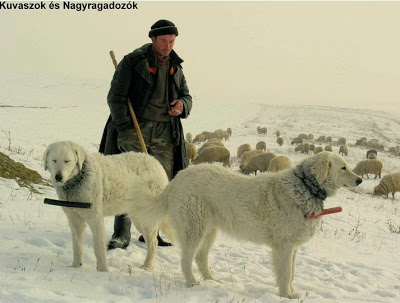
It’s being seen more frequently on Livestock Guardian Dogs in the American west, but certainly ranchers and shepherd in Europe have been using them for centuries.
“It” is a “dangle stick,” and it is quite literally a stick that hangs from the collars of LGDs throughout the world. Usually about a foot long, the dangle made of metal, plastic (like a PVC tube), or wood is attached to a hanging chain connected to a dog’s collar. Anyone unfamiliar with its purpose is either fascinated or horrified as it’s often mistaken as a form of training or even punishment, but it is neither. A dog can easily run, eat, lie down, or read the paper wearing a dangle stick. So what’s the point?
A dangle stick’s purpose is twofold. It can be used with younger dogs to curb their enthusiasm. It acts as a hindrance to prevent the dog from chasing stock they’re entrusted to watch by interfering with their movement. It slows them down when the rod bangs against their chest and makes movement uncomfortable. A correctly placed (and, made) dangle won’t harm or injure a dog, though supervision of the dog is important. Many shepherds feel that dangles are, in a word, stupid (and, in their view, humiliating for the dog). A dangle won’t prevent a crazed dog bent on chasing livestock, and many shepherds will often make a dangle very light-weight and hang it higher so that it won’t disrupt a dog’s ability to work. Most dogs learn how to move around with a dangle pretty quickly.
So why do shepherds bother with a dangle at all? It’s the law, and a dog without one can legally be shot by a hunter in many countries. In Bulgaria, for example, hunters are a powerful lobby, and that’s the main reason for the law there. In Romania where transhumance shepherds open graze their stock (read: no fences), it’s a legal requirement for all LGDs to wear a ‘dangle’ to protect wildlife (there, the dangle is called a “jujău”), especially animals like deer and wild boar. The stick identifies a dog as a working LGD which can prevent the dog from being shot by rangers mistaking it for a free roaming stray.
In the interest of presenting the other side of the coin, some would say that a small minority of shepherds have brought this on themselves, or more accurately, on their dogs. Many of these people live in poverty and can struggle to feed their dogs. When the dogs aren’t working, some will be released into the forest without their dangle sticks to hunt for themselves. If the shepherds are caught, they can be heavily fined. A dog without a dangle stick can be legally shot, and wildlife is even more at risk. It’s a bad situation all around.
Governments like that in Romania are trying to figure out a solution, and because shock training collars are regarded as less humane, the dangle remains.
Image of young Kuvaszok with the Nagyragadozók Természetvédelmi Program

I learn something new from you every day, NPDD. Never heard of a dangle stick before!
Thank you, Sharyn! We’re embarrassed to say that after all the years we’ve been in dogs, we’d never heard of a dangle before, either.
We learn from our readers, and in a conversation about LGDS, it came up. Wait until we get to yokes!